Today, consumers can pick from a wide range of cooking oils at the grocery store, such as olive oil, avocado oil, and sesame oil, but this wasn't always the case. In the days gone by, people often utilized more traditional, locally available oil sources like animal fats. No part of an animal was wasted -- the meat, organs, bones and marrow, and, of course, fat were all on the menu. Once extracted, the fat was rendered by simmering the solid fatty tissues at a low temperature, a process that both purified the fat and enhanced its shelf-life.
The use of natural animal fat gradually started to change at the beginning of the 20th century with the invention of hydrogenation. The process, which converted liquid oils into solid fats, allowed for the development of products such as Crisco and other plant-based oils. Backed by an aggressive marketing campaign that purported their health benefits, these products quickly overtook animal fat in popularity. It wasn't until much later that the world found out about the dangers of trans fats -- a byproduct of partial hydrogenation -- once again shifting consumer behavior.
Keen to learn more about the evolution of dietary fats? Read on for a deep dive into old-school fats people stopped using in their cooking, and why.
Read more: Sausage Brands Made With The Highest & Lowest Quality Ingredients
Lard
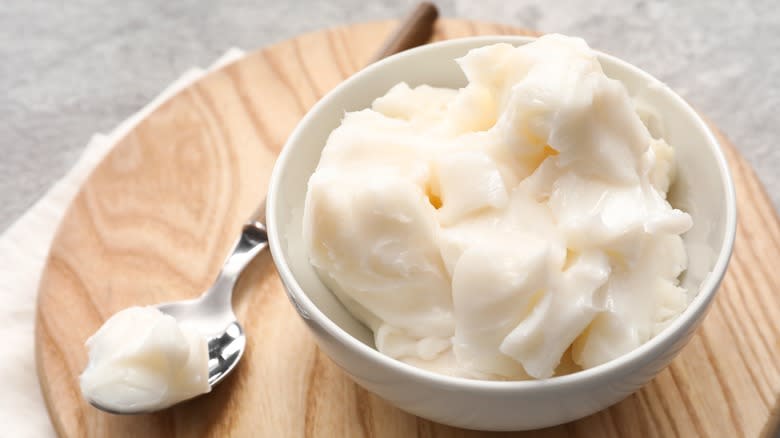
Lard, or rendered pig fat, used to be a staple in most kitchens a century or so ago -- and this isn't surprising since the pork industry was left with a lot of fat after packaging their main product. However, over the years, lard has gone out of style. Today, the product is nowhere to be seen — not in household kitchens anyway. This begs the question: What happened to this once popular baking and cooking staple?
Lard started losing its popularity in the early 1900s when product alternatives, such as Procter & Gamble's Crisco, started entering the market. It certainly didn't help that in the '50s, healthcare experts began cautioning American consumers about the health issues associated with the saturated fats found in lard. Nutritionists have now shifted to a gentler position, saying that saturated fat can be a part of a healthy diet if eaten in moderation. They have also found no direct link between saturated fats and heart disease, as previously asserted by researchers.
Lard has made somewhat of a comeback in recent years, with many extolling the virtues of lard over other oils due to its natural origins and unique flavor profile. For instance, Fran McCullough, the author of "The Good Fat Cookbook," told Food & Wine: "It is absolutely the best for frying. Nothing crisps food quite as well as lard." Home chefs agree, with one Quora user saying, "Good clean freshly rendered lard is great stuff. [It] gives a wonderful texture and taste."
Crisco
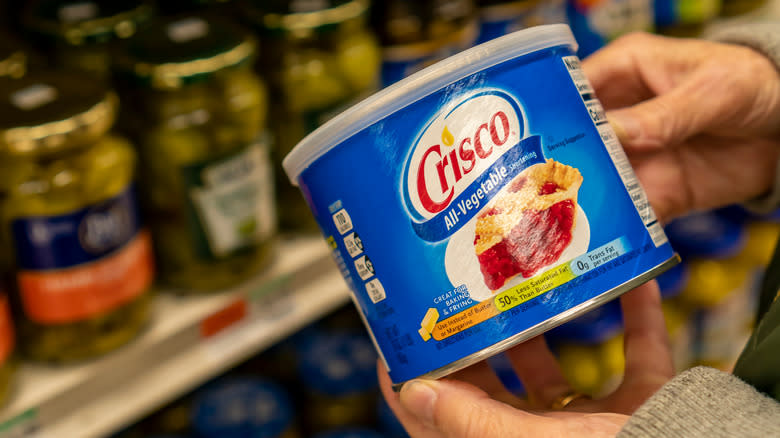
Many may not be aware that Crisco was invented in a lab in the early 20th century. The plant-based shortening was initially made from cottonseed and was produced with the intention of replacing lard, which was very popular at the time. Interestingly, Crisco's success was a direct result of a clever marketing campaign by Procter & Gamble.
Having found a way to transform liquid cottonseed oil into spreadable fat through hydrogenation, P&G released it on the market as Crisco in 1911. The company's inaugural advertising campaign claimed that the shortening was a "healthier alternative to cooking with animal fats ... and more economical than butter," (via The Weston A. Price Foundation). Soon after, the "Story of Crisco" was published, introducing housewives to 615 Crisco-based recipes, from pound cake to lobster bisque.
The robust marketing campaign convinced many. Within five years of its launch, Procter & Gamble was selling over 60 million cans of Crisco. As it later turned out, the company's health claims about Crisco were -- at best -- exaggerated. We now know that the product contained trans fats, which have been banned in the U.S. because they can increase the risk of cardiovascular diseases, diabetes, and even cancer. Today, Crisco is made from soybean oil and palm oil, and no longer contains trans fats to comply with the requirements of the FDA.
Chicken Fat
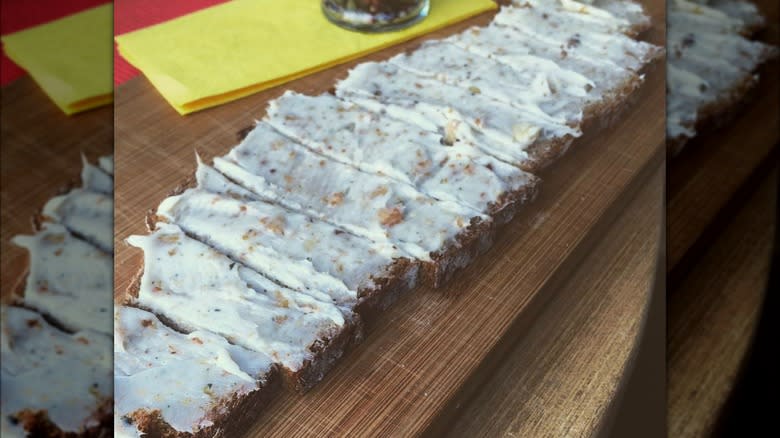
Also sometimes called schmaltz or liquid gold, chicken fat used to make a frequent appearance in Jewish and Eastern European cooking. One of the main appeals of chicken fat is that it has a similar flavor to butter without containing any dairy, making it perfect for those on a dairy-free diet. It can also form a part of the Jewish kosher diet, where dairy and meat can't be mixed together.
Despite its historical prevalence, chicken fat has almost completely vanished from the American-Jewish culinary tradition. Many have dropped the kosher tradition, replacing schmaltz with butter. In addition, as plant-based fat alternatives, such as Crisco, entered the scene, many turned to the fat substitute as another kosher alternative to animal fat. Notably, in its earlier days, Crisco marketed its products in both English and Yiddish to capture the attention of Jewish chefs. In the 1970s, as Americans started becoming more health-conscious, the saturated fat and cholesterol scare reduced the use of schmaltz in cooking even further.
While it's no longer popular, some still swear by chicken fat, favoring it in their matzo balls, roux, and sautéed dishes. Many are also taking matters into their own hands, and making the poultry fat at home. To make the poultry fat, simply freeze any leftover chicken skin and fat until you accumulate a sufficient amount to render. An even easier way to obtain chicken fat is by skimming it off the surface of homemade chicken stock.
Margarine
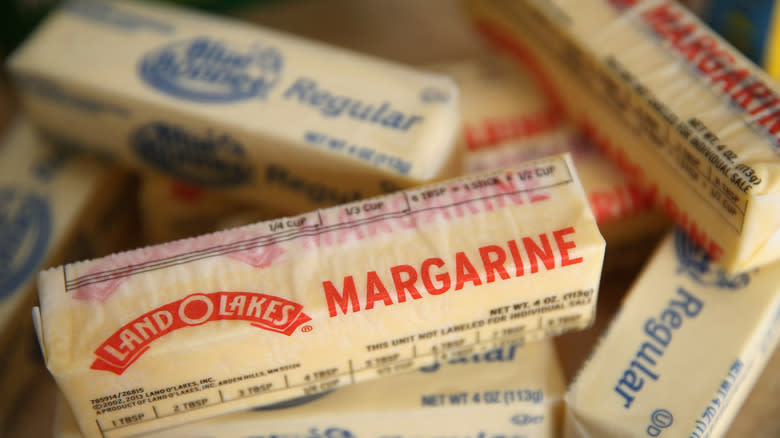
Margarine has lost the war to butter, but things weren't always this way. When margarine was first introduced in the U.S. in the late 19th century, butter usually came from small farms, which meant variations in quality. Since margarine was a budget-friendly substitute that was uniform in quality, it wasn't long before consumers were sold on the product. In fact, in 1902 alone, 126 million pounds of the spread were sold in the U.S. While the dairy industry did its best to stifle the product, in the three decades from the late 1920s to the 1950s, the sales of margarine quadrupled while butter sales declined by one-third.
Margarine was invented by a French chemist in 1869 after Emperor Napoleon III launched a competition calling for an affordable butter substitute amid food shortages. While the first margarine was made with beef tallow, this was substituted with vegetable oils after the discovery of hydrogenation in the early 20th century. While this ingredient change was appealing at the time, it also ended up being margarine's downfall since partial hydrogenation produces trans fats. More specifically, when in the 1990s trans fats fell out of favor due to health concerns, margarine also started losing ground. While today margarine products no longer contain trans fats, they have never regained their popularity.
Beef Tallow
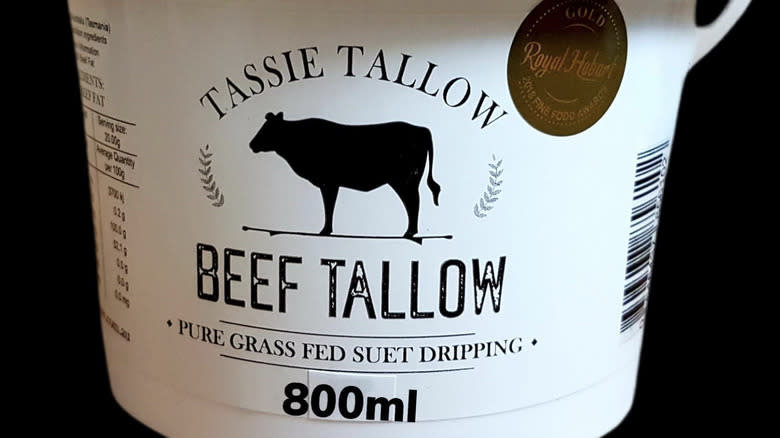
While there was a time that beef tallow was vilified for its level of saturated fat, research has shown that the dietary fat probably isn't as unhealthy as it was once believed to be. Beef tallow is also loaded with nutrients, such as vitamins A, D, E, K, and B1. The ingredient is also rich in conjugated linoleic acid (credited with reducing inflammation), choline (great for the nervous system), and palmitoleic acid (known for its antimicrobial properties).
Perhaps the most well-known product that ever contained beef tallow, or rendered beef fat, was McDonald's French fries. To the dismay of many, the fast food giant ended up replacing beef tallow with vegetable oil in 1990 after succumbing to pressure from various groups that claimed that saturated animal fat contributed to heart disease.
The main culprit in this crusade was American Businessman, Phil Sokoloff, who blamed McDonald's for a heart attack he suffered in 1966 and pumped a lot of money into campaigns against the chain. After customers started complaining about the bland taste of the chain's new take on French fries, McDonald's started upgrading the product with natural beef flavors. However, this move ended up costing the chain a cool $10 million after it was sued for not disclosing that their French fries weren't vegetarian.
Whale Oil
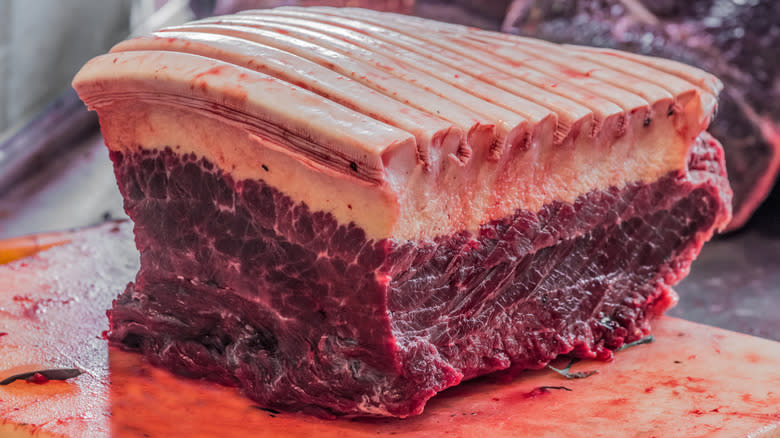
The fact that oil was once made from whale blubber may be hard to imagine today. More specifically, sperm oil was sourced from sperm whales, melon oil from small toothed whales, and train oil from baleen whales. The product was mainly used as a lubricant for machinery, lamp fuel, and an ingredient in soap. Although whale oil is no longer used for these purposes, whale blubber is still sometimes rendered into fat. The robust layer of fat under the skin of these majestic sea creatures can also be cooked in soups or stews, dried, and even eaten raw.
As its industrial uses waned in the early 20th century, whale oil started being used in the manufacture of margarine. In fact, the product was a primary ingredient in margarine until it started being replaced by vegetable oils in the 1930s. Nevertheless, whale fat was still used in the product when the International Whaling Commission implemented a moratorium on commercial whaling in 1986 as a response to overfishing and the declining number of whales.
Goose And Duck Fat
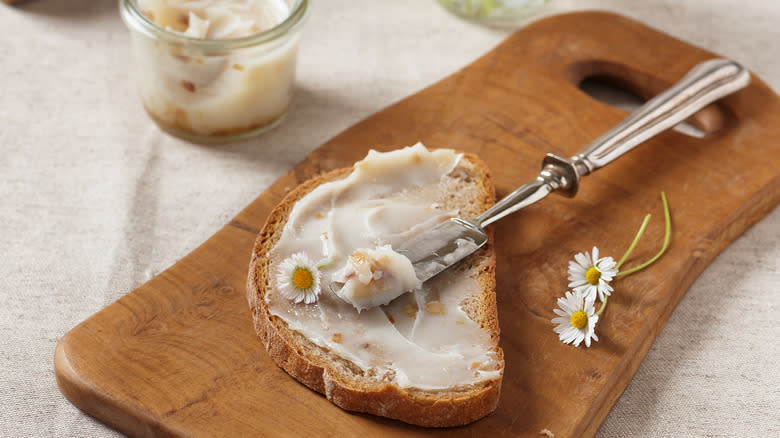
Duck and goose fat are very similar. One of the only notable differences between the two products is that goose fat is slightly higher in saturated fat than duck fat. Goose and duck fat have also been compared to olive oil due to their similar levels of oleic and linoleic acids, both of which have been credited with reducing the risk of heart issues. A huge bonus of cooking with duck or goose fat is that even though they are higher in saturated fat than olive oil, you don't need to use as much of them when cooking. Randal Oulton describes this for Practically Edible, saying that one tablespoon of duck fat can easily replace a "few glugs" of olive oil.
Both goose and duck fat are rich in flavor, but not to the extent where they would overpower a dish. Most famously used to make roasted potatoes, goose fat also stands out in other culinary endeavors, as explained by one Reddit contributor. "[My grandfather] would mix the fat with finely chopped onion, thyme and salt and use it as a spread on rye bread. Heaven!" Duck fat has been equally as popular with home chefs, with one Reddit user saying, "I've rendered some duck fat and made some homemade fries. You know the flavor of crispy chicken or duck skin off a freshly roasted bird? The fries take on a bit of that flavor."
Bear Fat
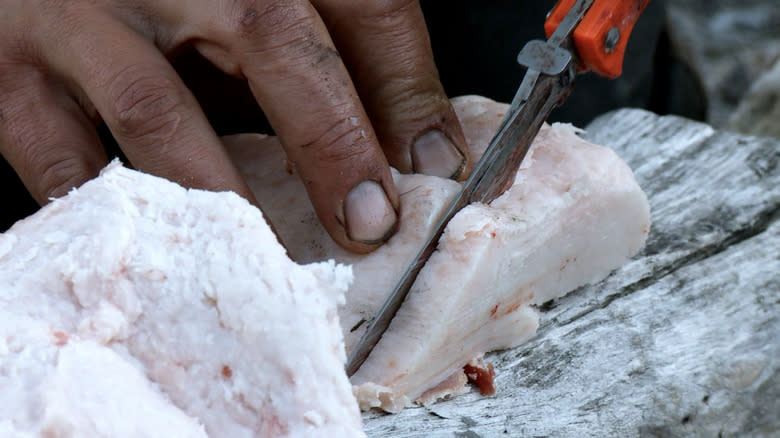
Throughout the years, bear grease, or bear fat, has had many uses. It was utilized as a hair conditioner, for preserving leather, as a fuel for oil lamps, and even as a means of telling the weather. Of course, bear fat has also been used in a variety of culinary applications, including frying, as well as making pastries and cookies. In addition, traditionally many trappers used to stir a spoonful of bear fat into their coffee as a source of energy on cold winter's days.
While bear grease isn't something you'll readily find at a supermarket, it can still be found in regions where hunting bears is a part of the local tradition. Notably, bear hunting is still allowed in the majority of U.S. states, which means that bear grease remains more popular than most of us probably believe and can probably be obtained from hunters. The best time to collect bear fat is in the fall when bears are preparing for hibernation. Conversely, the worst time to obtain bear fat is in the spring after bears have used up their fat reserves.
Suet
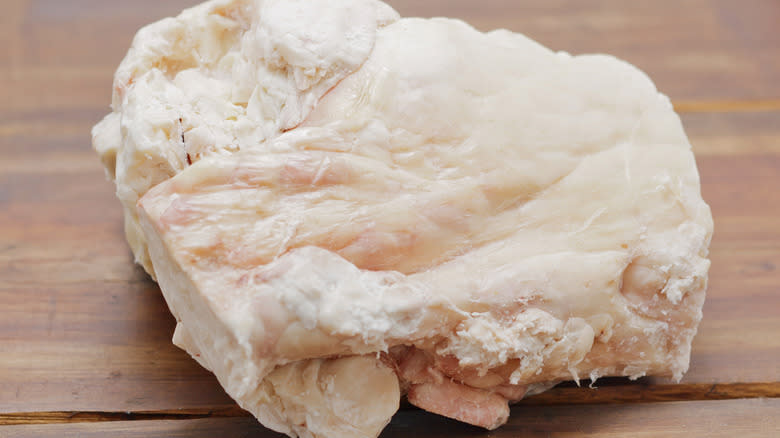
Suet is a hard fat that comes from the kidney and loin area of a cow. Unlike beef tallow, which is rendered, suet is typically used in its natural state. Also unlike muscle fat, suet is rich in triglyceride stearin, which makes it perfect for adding a spongy texture to puddings and crumbliness to pies. Since it doesn't have a strong flavor, suet is also used to infuse dishes with moisture. Suet is most commonly made from beef, but it can also come from lamb, pork, sheep, and venison.
While suet isn't very popular in the U.S., it's sometimes used in the U.K. to make puddings, pastry, and dumplings. Perhaps one netizen sums this up best on Ask MetaFilter, explaining, "I got some from a Seattle butcher once while experimenting with English-style puddings; that was probably a decade ago, and I probably still have it in the deep freeze. I don't think I've ever seen a recipe that wasn't for puddings or wasn't 100% English Cuisine that called for suet." As such, it's not surprising that suet isn't easy to find in the U.S. as highlighted by another post: "[It] tends to be a specialty item here that you need to go to an actual butcher and pre-order because it's a specific type of fat. It's not something you're going to find in any regular supermarket."
Read the original article on Mashed
https://news.google.com/rss/articles/CBMiSGh0dHBzOi8vdWsuc3R5bGUueWFob28uY29tL29sZC1zY2hvb2wtZmF0cy1wZW9wbGUtc3RvcHBlZC0yMTMwNTU5ODkuaHRtbNIBAA?oc=5
2024-06-01 21:30:55Z
CBMiSGh0dHBzOi8vdWsuc3R5bGUueWFob28uY29tL29sZC1zY2hvb2wtZmF0cy1wZW9wbGUtc3RvcHBlZC0yMTMwNTU5ODkuaHRtbNIBAA
Bagikan Berita Ini

















0 Response to "Old-School Fats People Stopped Using In Their Cooking - Yahoo Lifestyle UK"
Post a Comment